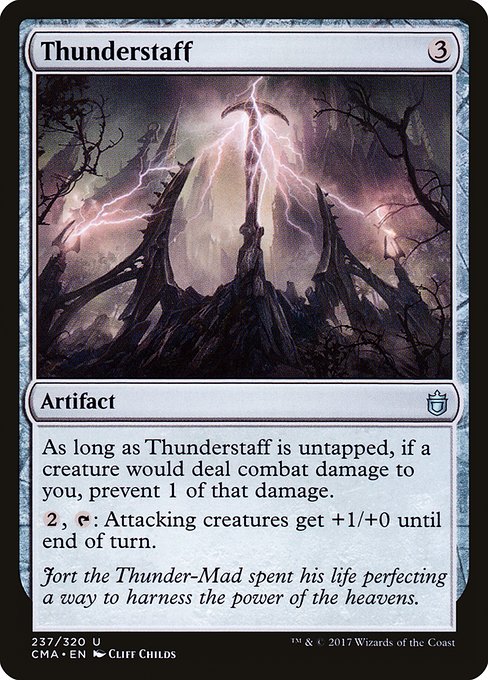
Image courtesy of Scryfall.com
Thunderstaff as a Thread in MTG’s Multiverse Mosaic
Magic: The Gathering doesn’t just tell stories in single sets; it builds a tapestry where artifacts, legends, and planeswalkers echo across eras. Thunderstaff, a humble yet potent artifact from Commander Anthology, is a prime example of how cross-set storytelling can weave a larger narrative from a single card’s spark. This 3-mana artifact—colorless and quietly reliable—embodies the idea that some tools are timeless, silently shaping battles and myths long after their first spark of existence. 🧙♂️🔥
A flavorful gateway to a wider storm
“Jort the Thunder-Mad spent his life perfecting a way to harness the power of the heavens.”
Flavor text is the living breath of MTG lore, and Thunderstaff carries it with the same thunderous confidence as the storms it implies. While its origin lies in the Commander Anthology set (a collection designed for epic, shared battles), the flavor radiates outward: a storm-wright’s tool that feels at home in a long-running saga about power, responsibility, and the unpredictability of magic. When you glimpse Thunderstaff, you’re reminded that storms aren’t bound to one plane; they reverberate across worlds, and the artifacts that weather those storms become touchpoints for players tracing threads from Dominaria to planes unknown. ⚡🎲
How the card’s frame and text tell a cross-set tale
Thunderstaff’s rules text is a compact narrative engine. It reads: “As long as this artifact is untapped, if a creature would deal combat damage to you, prevent 1 of that damage. {2}, {T}: Attacking creatures get +1/+0 until end of turn.” The untapped condition is more than a gameplay constraint—it's a storytelling beat: a shield that remains vigilant until you actively unleash its storm. In cross-set storytelling terms, that mechanic mirrors recurring motifs across MTG’s libraries: guardians who hold back a portion of their power until the moment it matters most, then turn the tide with a decisive burst of offense. The mana sink {2} to empower attackers is a small, clever nod to the way lore often marks a turning point—one moment of quiet, followed by a surge of momentum that reshapes the battlefield. 💎⚔️
Artistically, Thunderstaff sits in a borderless, black-frame world that suits the artifact’s neutral, all-planes vibe. Cliff Childs’ illustration channels the calm before the storm: a staff that hums with potential, its runic etchings catching sparks of electricity. The card’s rarity—uncommon in Commander Anthology—belies the strategic depth it offers in decks built around artifact synergy, stax-lite defenses, and tempo swings. It’s a quiet legend that rewards patient play and thoughtful cross-set storytelling—the kind that rewards collectors who trace the lineage of ideas through different printings and sets. 🎨
Strategic threads: using Thunderstaff to link defenses with offense
In a broader cross-set narrative, Thunderstaff functions as a “bridge” card: it protects you when untapped, a motif you’ll see echoed in other artifacts and stax elements across sets, then it hands you a precise weapon to push partners and creatures into favorable combat scenarios. The prevention clause—“if a creature would deal combat damage to you, prevent 1 of that damage”—pairs beautifully with any deck that leans on resilience or creature-based attrition. It’s the kind of interwoven design that MTG designers love: a simple tool with a quietly ambitious arc. And that arc resonates with players who appreciate how individual cards can reflect larger themes, even when printed years apart or in separate contexts. 🧙♂️💥
Cross-set storytelling through design, art, and flavor
Thunderstaff’s place in Commander Anthology anchors it in a tradition of artifact-centric storytelling that travels across MTG’s multiverse. Its flavor text ties to a mythic craftsman; its rules tap into the duality of defense and offense; and its artwork hints at a broader mythos about wielders who seek to mirror the storm’s order and chaos. Across sets, similar artifacts—each with unique mechanics—create a shared language. A single Thunderstaff moment can echo in the design of future artifacts: a device that protects the bearer while enabling a sudden, brutal swing on the following turn. That’s the essence of cross-set storytelling: a chorus of cards, each a note, harmonizing to tell a larger story about power, responsibility, and the storm’s inexorable pull. 🧩🎶
Collector’s lens: value, rarity, and the heartbeat of a set’s storytelling
As an uncommon artifact from a Commander-focused release, Thunderstaff finds its resonance with dedicated collectors who chase not just power but provenance. Its price point—reflecting both playability in modern formats and its role in Commander circles—offers a tangible reminder that storytelling and value often travel together. The set’s 2017 release date places Thunderstaff in a lineage of artifacts that players remember for their understated elegance and practical utility. The card’s non-foil, reprint-friendly availability makes it a favorite for budget-conscious decks that still want to honor MTG’s grand tradition of cross-set storytelling. And when you pair Thunderstaff with other storm-themed or artifact-centric cards, you can feel the pulse of a wider saga—one that travels across planes and generations. 🔥💎
For readers who love blending lore with deck-building, Thunderstaff serves as a reminder that a single artifact can spark conversations that reach far beyond a single table. It’s a reminder that MTG’s multiverse is less about isolated episodes and more about a living chronicle—one where a quiet, untapped relic can become the fulcrum of a dozen stories whispered across formats and timelines. 🧙♂️
Slim Glossy Phone Case Lexan PolycarbonateMore from our network
- https://blog.digital-vault.xyz/blog/post/craft-seo-friendly-headlines-that-drive-traffic-and-rankings/
- https://blog.digital-vault.xyz/blog/post/how-to-choose-color-palettes-for-digital-paper/
- https://transparent-paper.shop/blog/post/subtle-digital-linen-paper-effects-for-elegant-print-design/
- https://crypto-acolytes.xyz/blog/post/sports-teams-tap-crypto-for-fan-engagement-and-revenue/
- https://crypto-acolytes.xyz/blog/post/building-a-minecraft-villager-trading-hall-your-complete-guide/